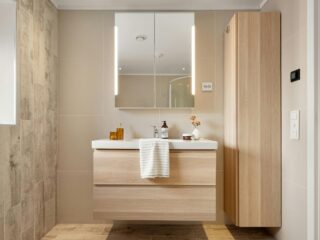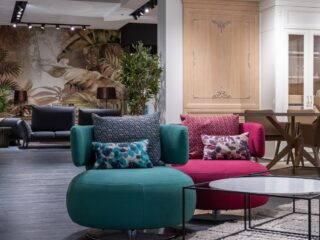
The design of your home is about more than just looking good; it impacts your daily life in meaningful ways. Aesthetic choices play a big role in how functional your space is, influencing comfort and usability. For instance, the right colors can create a welcoming atmosphere, while materials can affect durability and maintenance.
Statista notes that in 2024, the global home décor market is projected to reach an impressive revenue of $133.60 billion. A steady annual growth rate of 3.89% from 2024 to 2029 can be expected. The United States is set to lead the global home décor market, generating around $35.44 billion in revenue in 2024. A key trend to watch is the growing demand for sustainable and eco-friendly products, especially in countries like Germany.
Even small details, like window trim, can enhance both beauty and energy efficiency. Each decision shapes how your home serves you and your family. When designing your space, it’s essential to consider how aesthetics and functionality work together.
Color Schemes and Their Impact on Space
Color schemes play a vital role in home design, influencing both the look and feel of a space. In addition to aesthetics, the choice of colors can enhance the overall functionality of the room by affecting lighting, atmosphere, and mood.
Lighter colors can make a room feel larger and more open, which is especially beneficial in smaller areas. Bright whites, soft pastels, and light neutrals reflect more light, enhancing natural illumination and reducing the need for artificial lighting. Conversely, darker hues can create a cozy, intimate atmosphere but may also make a room feel smaller and require additional lighting solutions.
Real Simple states that if you’re concerned about a room appearing too dark, consider adjusting the paint by mixing in 50% white. This approach helps lighten the space while maintaining the original color tone. Opting for flat paint on both the walls and ceiling can also enhance the modern, matte finish that’s currently trending.
Moreover, color choices can significantly influence emotions and behavior. Blues and greens are great for promoting calmness in a room. In contrast, vibrant reds and oranges can boost energy levels. When choosing colors, think about their aesthetic impact and how your family will use and feel in each space. Balancing aesthetics and functionality through color choices leads to a more pleasant and practical living environment.
How Do Accents Impact Color Schemes?
Accent colors play a crucial role in enhancing overall color schemes. They add depth and interest, creating focal points within a room.

Homeowners can enhance their space by strategically using accent colors in decor or furnishings, creating a balanced aesthetic that reflects their personality.
Functional Architectural Components
The Architect’s Newspaper reports that functional architectural elements are crucial for safety and efficiency in buildings. Nearly one-third of architectural insurance policies face claims related to design errors each year.
To address challenges like climate change, architects must balance artistic expression with essential building science. This approach guarantees that architectural designs are visually appealing while also maintaining essential functionality for the safety and comfort of occupants.
Architectural components, such as window trim, moldings, and built-in shelving, serve as both functional elements and aesthetic enhancements in your home. While these features contribute to the overall visual appeal, they also play crucial roles in improving functionality. For instance, window trim frames views and adds character while helping insulate windows, improving energy efficiency.
According to Belco Forest Products, window trim is more than just a decorative detail; it significantly influences the look and feel of a room. Whether your property is modern, classic, or anywhere in between, it enhances the architectural style by giving the windows a polished touch. The choice of material and color for window trim can also affect natural light, creating brighter spaces or adding warmth.
Similarly, crown molding can elevate the design of a room while hiding imperfections where walls meet the ceiling, providing a polished finish. Built-in shelves can optimize vertical space, reducing clutter and enhancing organization while also serving as a decorative display area.
Aesthetics and usefulness may be harmoniously combined by homeowners via the careful integration of various architectural elements. This method guarantees that every little thing improves the overall living experience in the area.
What Features Improve A Home’s Energy Efficiency?
Energy-efficient features help reduce utility bills and minimize environmental impact. Lowering energy usage may be achieved with options like programmable thermostats, energy-efficient appliances, and insulated windows. Implementing these elements not only benefits homeowners financially but also promotes a more sustainable lifestyle.
The Importance of Layout Design
The layout of a home is one of the most critical aesthetic choices impacting its functionality. Families or people who value connectedness will find an open floor plan ideal since it may foster a feeling of space and social connection.
The Spruce highlights that before the 1940s, most homes had conventional floor layouts with distinct rooms for various purposes. The rise of open floor plans began with architectural innovations that combined living spaces, enhancing family interaction. Recently, homeowners have shifted back to closed-off rooms for better privacy and organization, reflecting changing design preferences.
In contrast, a more traditional layout with distinct rooms can provide privacy and reduce noise, which may be preferable for individuals who value solitude.
Additionally, the arrangement of furniture and fixtures must facilitate movement and accessibility. A well-thought-out layout ensures that pathways are clear, allowing for smooth traffic flow between rooms. It also allows for efficient use of space, maximizing storage and minimizing clutter.

Incorporating elements such as multi-functional furniture like storage ottomans or foldable tables can enhance usability while maintaining an appealing aesthetic. Ultimately, the layout of your home should reflect your lifestyle and needs, seamlessly merging beauty with practicality to create a comfortable living space.
What are the Benefits of An Open Floor Plan?
An open floor layout fosters social contact among family members and gives the impression of space. This arrangement allows visitors to freely roam from one room to another, making it ideal for staying connected. It also enhances the natural light flow, which makes the house feel airy and welcoming.
The relationship between aesthetics and functionality in home design is key to achieving a comfortable living space. Choices like color schemes, architectural features, and layout all play a vital role in how a home operates, directly affecting comfort and usability.
When homeowners take these elements into account, they can craft environments that are both visually stunning and practical. A thoughtfully designed home not only reflects personal style but also caters to everyday needs. Homeowners can enhance their daily lives and create spaces that truly feel like home by blending beauty with function.





